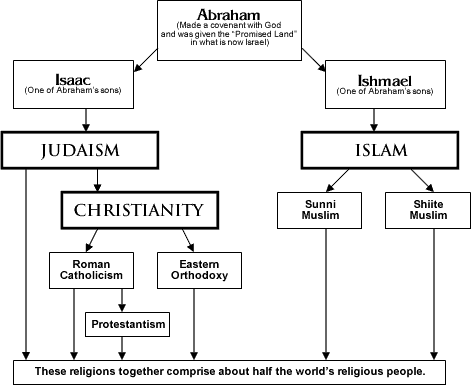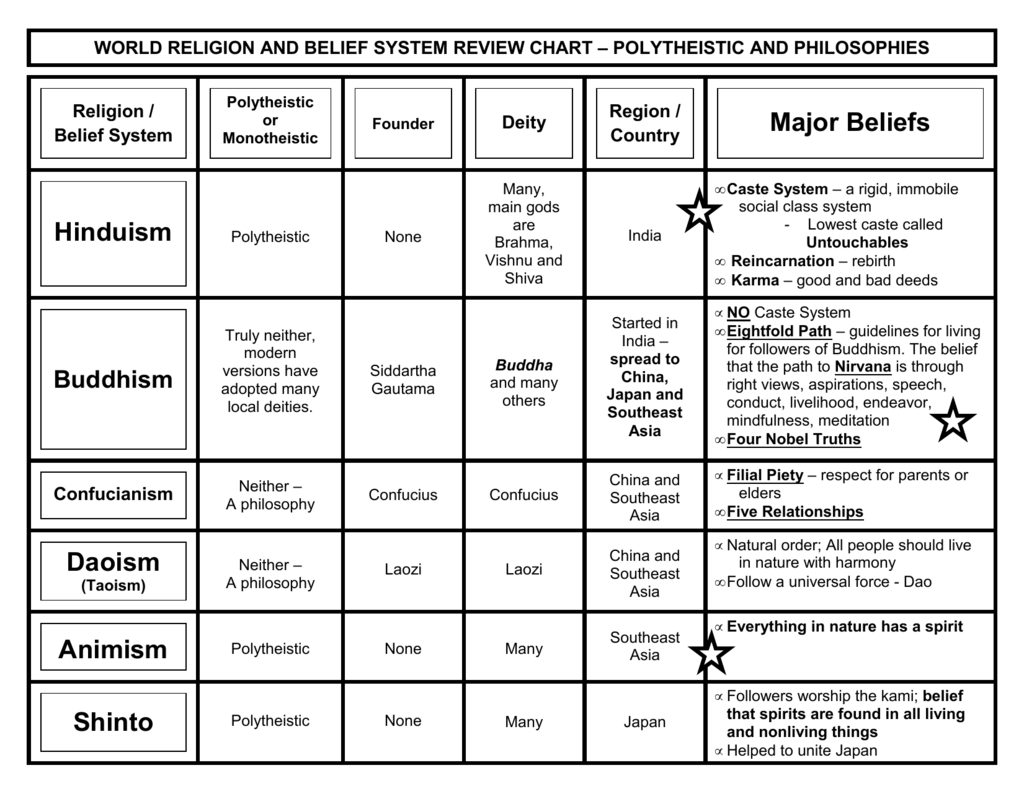What exactly makes a religion a World Religion? and Who gets to decide? Any course on contemporary world religions needs to start by answering the question. This lesson will provide a rudimentary definition, address problems associated with the term, and introduce the ‘big five’ world religions covered in this course.
Lesson Objectives
- define ‘world religion’
- identify the ‘big five’ world religions recognized in academia
- describe the critique of world religion as a category
- take a position on the criteria for a world religion
In this course, world religion will refer to the five largest (in population and/or influence) and most geographically widespread religious movements: Judaism, Christianity, Islam, Hinduism and Buddhism. As a group, these religions are sometimes referred to as the ‘big five.’ It is important to note, however, that many scholars also include additional widespread and populous religions such as the Bahá’í Faith, Sikhism, and Zoroastriainsim as world religions. In light of the limited time available in this introductory course, this course will be limited to the ‘big five,’ yet students are welcome to address other populous, influential and widespread religions in individual assignments and projects.
A Critique of World Religion as a Category
The concept of world religion, also known as the ‘world religion paradigm’ emerged in the mid-twentieth century in institutions of higher education. Although the paradigm aimed to promote the study of global religious influences, it also received significant criticism by scholars who problematized the paradigm as one that is based on power. Critics point out that the most globally powerful religions are privileged at the expense of less powerful yet equally as significant religious groups.
The following podcast by The Religious Studies Project by James L. Cox addresses the problems associated with creating and teaching a world religion paradigm in colleges and universities. As you listen to this podcast, consider the benefits and consequences of the world religion category and formulate your own opinion of the world religion paradigm.
Recognizing that the concept and model of world religions is problematic, this course will still rely on the ‘big five’ paradigm. Yet, the following lessons, Globalization & Diaspora and Symbols & Meanings, will provide tools to move toward a more sophisticated understanding and analysis of how global historical process and individual interpretation has led to a rich and diverse global religious landscape today.
The ‘Big Five’ World Religions
This class begins by providing scholarly tools for an academic examination of religious phenomena, and then moves on to examine each of the big five world religions. The examination begins with the ‘Abrahamic’ world religions that originated in the Middle East (Judaism, Christianity and Islam) and proceeds to the world religions that originated in India (Hinduism and Buddhism).
The ‘Abrahamic’ Three: three religions, one God
Abrahamic religions refers to three of the world’s major religions, Judaism, Christianity, and Islam, that originated in the Middle East and are inextricably linked in history and beliefs. While there are some variations between the three distinct yet related religions, all generally recognize a man named Abraham as the first prophet, or man who has made a covenant (agreement) with a single, monotheistic, deity (referred to as ‘God’.
- Judaism is the oldest surviving monotheistic religion arising in the eastern Mediterranean during the second millennium BCE. In addition to Abraham, a man named Moses is believed to be a significant prophet who received a collection of laws, or commandments, directly from the one God. These laws are enscripted in a sacred book called the Torah, (also known as the Pentateuch which refers to five books) and the Talmud is a commentary on the Torah which was completed in the fifth-century C.E.) A significant aspect of Judaism that is a major influence in Christianity is that the religion prohibits believers to worship or believe in any other god.
- Christianity also began in the Middle East as an offshoot from Judaism. The religion rests on the teachings and works of Jesus who is believed by most Christians to be the ‘son of God’ who manifested in the form of man in the first century C.E. While interpretations within Christianity vary, Jesus is generally viewed as a messiah, or savior, that abolishes strict adherence to god-given laws in Judaism and preached salvation through faith which is enscripted in a collection of books referred to as the Gospel, which literally means ‘good news.’ The Christian bible consists of an ‘Old Testament’ which refers to the early Jewish texts, and the ‘New Testament’ which refers to Christian teachings and beliefs. While Jews and Christians worship the same one god with different names, Jewish beliefs generally do not recognize Jesus as neither the son of God nor as a prophet.
- Islam emerged in the Middle East during the seventh century C.E. through the teachings of Mohammed who is believed by Muslims to be a prophet in a city called Mecca. Islamic beliefs rest on five pillars which are enscripted in the Quran: 1. Belief in only one God, and Mohammed is his prophet, 2. pray five times a day, 3. complete a pilgrimage to Mecca, 4.) give to the poor, and 5.) fast during a holiday called Ramadan. Muslims share the same God as Jews and Muslims but with a different name. Muslim beliefs generally recognize Jesus as a prophet but not as the son of God. All three prohibit worship of other gods.
Within a century, Islam spread across North Africa, Europe, and Central Asia, and Islam has continued to grow and become the largest world religion in terms of population. Christianity spread into Europe after it became the official religion of the Roman Empire in the 4th century CE and expanded worldwide during European colonialism in the 15th to 20th centuries. Judaism is the least populated religion of the five world religions, yet it is considered a world religion due to the religions significant influence in Islam and Christianity.
The schematic below shows the relationship between Judaism, Christianity and Islam.

Religions of India
The two remaining world religions, Hinduism and Buddhism, originated in India and spread throughout the Asian continent.
- Hinduism, or Sanatana Dharma (“eternal spiritual path”), refers to a broad range of religious communities with a shared origin that began about 4000 years ago in the Indus Valley. The foundation for Hindu philosophy, religion, and customs are enscripted in Vedas, and the fundamental teachings of Hinduism are contained in the concluding portion of the Vedas referred to as Upanishads. Hindu beliefs generally rest on the notion that the nature of a person rests beyond the body and mind and within a spirit directly connected to a God that is present through out all of creation. Unlike the Abrahamic religions, Hinduism is a polytheistic religion that recognizes more than one manifestation of God or gods. Hinduism is the world’s oldest living religion, with a wide variety of diverse sects.
- Buddhism, like Hinduism, also emerged in India sometime between the sixth and fourth centuries BCE. The religion rests on the teachings of the Buddha, or enlightened one, which are enscribed in Buddhist manuscripts. Buddhist beliefs generally rest on the notion that one can overcome the suffering associated with samsara, the cycle of life and death, by following certain paths to enlightenment, or buddhahood, to reach nirvana through practices and ideas such as the Eightfold Path and the Four Noble Truths.
While Buddhism and Hinduism originated in India, each religion has a unique historical context that has resulted in a wide range of diverse traditions, beliefs and practices. Buddhism and Hinduism share the concept of reincarnation. While Hinduism recognizes several different gods or manifestations of a single God, many Buddhists consider Buddhism more of a philosophy than a religion because it does not include a God or gods, and believers are usually taught a practice rather than rules or rituals. More than one billion people believe or practice some aspect of Hinduism throughout the world today. Buddhism spread throughout much of Asia and gained momentum in the United States and Europe during the mid-twentieth century. It is the fourth largest religion with more than 520 million followers and several different practices worldwide that include elements of ancient Chinese Confucianism and Taosim beliefs and practices such as ancestor veneration, meditation, and Zen.

The second half of this course will provide a more detailed account of the histories, beliefs and practices shared by members of each religion. To review information about the five world religions presented in this lesson, and to learn more specific details for each, watch the TED-Ed video below.
This lesson introduced foundational information for this course by establishing a definition for ‘world religion,’ explaining the problems associated with the concept of a ‘world religion,’ and providing a brief description of the ‘Big Five’ world religions addressed in the course. The next lesson will address theoretical frameworks to interpret religion and religious phenomena.
Your Score:
Your Ranking:
Resources:
- The Correlates of War Project: World Religion Dataset (csv)
- The World Religion Project
- Pew Research Center: The Global Religious Landscape
- PBS Resources: Global connections, world religions
For Online Discussion: Review the resources listed above and use terms and concepts (in bold and italics) from this lesson, describe your opinion on what qualifies a religion to be recognized as a ‘world religion’? Do you think the academic categorization of the ‘big five’ is a useful tool, or does it promote the domination of a few religions at the expense of many other religions that may be just as significant? (250-500 words. Be sure to adhere to discussion criteria specified in the syllabus; use terms and concepts from the lesson, format and cite your sources, and respond to at least two other student posts to receive credit.)
When you complete the discussion, move on to the Globalization & Diaspora lesson.
